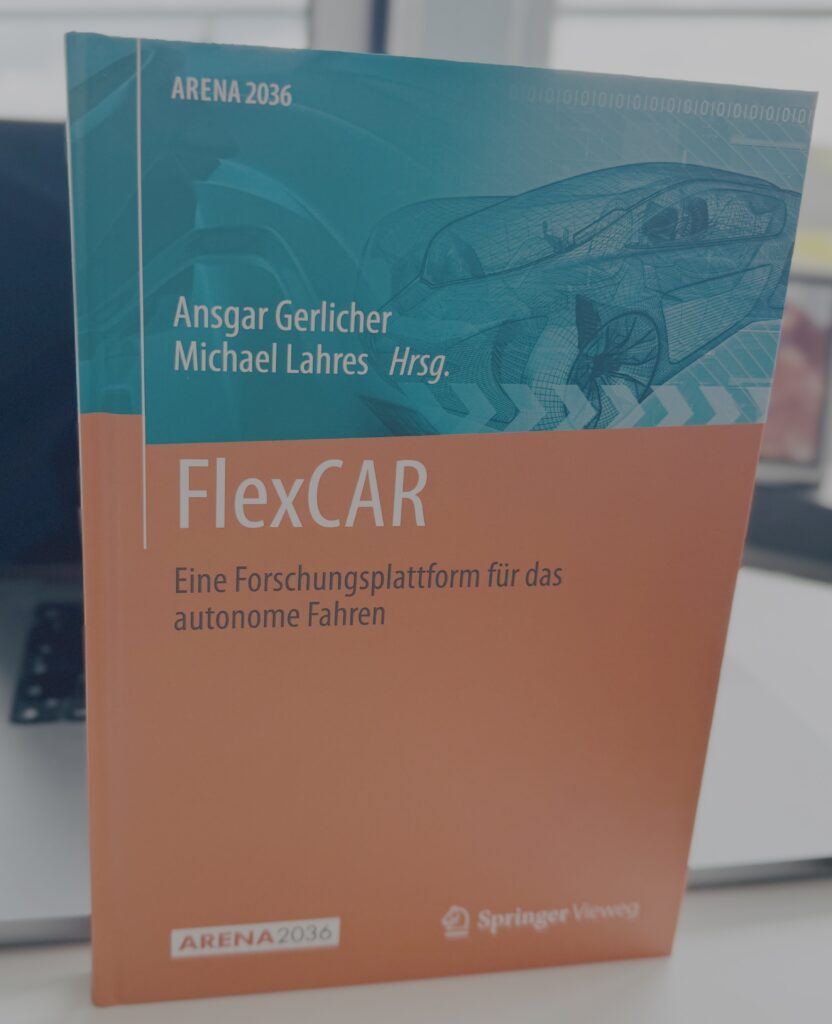The Book
I am excited to announce the release of my latest book, FlexCAR – Eine Forschungsplattform für das autonome Fahren, now published by Springer and available here:
👉 https://link.springer.com/book/10.1007/978-3-662-69750-4
This book is the culmination of several years of interdisciplinary research, technical development, and collaborative innovation around one of the most transformative technologies of our time: autonomous driving.
Why FlexCAR?
The FlexCAR platform was designed to fill a crucial gap in autonomous vehicle research: the need for a modular, adaptable, and real-world test environment. As the automotive world moves rapidly toward increased automation, researchers need hands-on tools to explore technical, legal, and social dimensions in parallel. FlexCAR provides exactly that – a flexible research vehicle that allows for dynamic testing of new sensors, AI algorithms, connectivity systems, and human-machine interfaces.
🔗 Learn more about the FlexCAR project: https://arena2036.de/flexcar-vbp/
Inside the Book
FlexCAR – A Research Platform for Autonomous Driving is structured to reflect the complexity and richness of this interdisciplinary field. Topics include:
- Sensor technologies and perception: How different sensor modalities (LiDAR, radar, cameras, IMUs) are integrated and interpreted.
- System architecture: The modular and distributed software design behind the platform, including middleware, safety layers, and real-time control.
- Connectivity: The integration of vehicle-to-vehicle (V2V) and vehicle-to-infrastructure (V2I) communication, including remote diagnostics and over-the-air updates.
- User interaction: Design strategies for in-car experiences and the psychological factors that shape trust in automation.
- Legal and ethical aspects: How current laws interact with emerging technology, and how we can responsibly approach ethically ambiguous scenarios.
- Applications and case studies: Real examples of FlexCAR in action—on campus, in city traffic simulations, and in collaboration with leading industrial partners.
The book combines theoretical depth with practical insights and offers a valuable resource for researchers, developers, and students.
An Interdisciplinary and Collaborative Team Effort
This publication is the result of an extraordinary collaborative effort. I want to thank all co-authors for their expertise and dedication. Together, we explored how autonomous driving is not just a technical challenge but also a societal and ethical one.
I’m deeply thankful to each contributor for their expertise, dedication, and thoughtful engagement. The richness of this book is a direct result of this interdisciplinary exchange.
Research Supported by the BMBF
Most importantly, I want to gratefully acknowledge the Federal Ministry of Education and Research (BMBF) and the Projektträger Karlsruhe (PTKA) and especially in person Mrs. Dr. Ernst, whose financial and institutional support was instrumental in realizing this project. Their commitment to fostering innovation, research, and technology transfer in Germany provided both the foundation and the momentum for the FlexCAR initiative.
What Makes FlexCAR Unique?
Unlike many theoretical models or simulation-only platforms, FlexCAR is designed for physical deployment. It’s a real vehicle-based platform, adaptable to various research needs, from AI-based driving decisions to interface testing and legal prototyping.
This dual nature—grounded in both theory and practice—makes it a valuable bridge between academic inquiry and industrial application.
Moreover, FlexCAR is not a closed system. It was intentionally built to be shared, extended, and adapted by others. That’s why we hope this book not only informs but inspires new projects, partnerships, and ideas.
A Milestone – But Not the End
While the publication of this book is a significant achievement, our work does not stop here. In fact, FlexCAR has laid the foundation for the next major research phase: CARpulse.
CARpulse builds on the learnings from FlexCAR and pushes forward into new territory—focusing on immersive simulations, extended vehicle diagnostics, driver state monitoring, and innovative user experiences. It extends the platform’s capabilities and deepens its real-world applicability, especially in the context of autonomous driving and digital vehicle ecosystems.
🔗 Learn more about CARpulse: https://arena2036.de/carpulse/
Looking Ahead
FlexCAR represents a bridge between theory and practice, between disciplines, and between today’s mobility systems and those of the future. It is my hope that this book will not only inform but inspire new research, ideas, and collaborations.
If you’re working in the fields of mobility, robotics, AI, human factors, or policy—let’s connect. This project thrives on openness, exchange, and innovation.
Thank You
Publishing this book has been a deeply rewarding step in my professional journey. I’m grateful to everyone who has contributed to the project and look forward to where it leads next. Special thanks goes to Dr. Klaus Fürderer, who lead the FlexCAR team in the early years and very special shout out to Dr. Michael Lahres, Co-Publisher and successor of Klaus and now project lead in CARPulse for the Mercedes team.
📘 Get the book: https://link.springer.com/book/10.1007/978-3-662-69750-4
🔧 Learn about the platform: FlexCAR project page
🚀 See what’s next: CARpulse follow-up project
Stay tuned – the journey continues.


